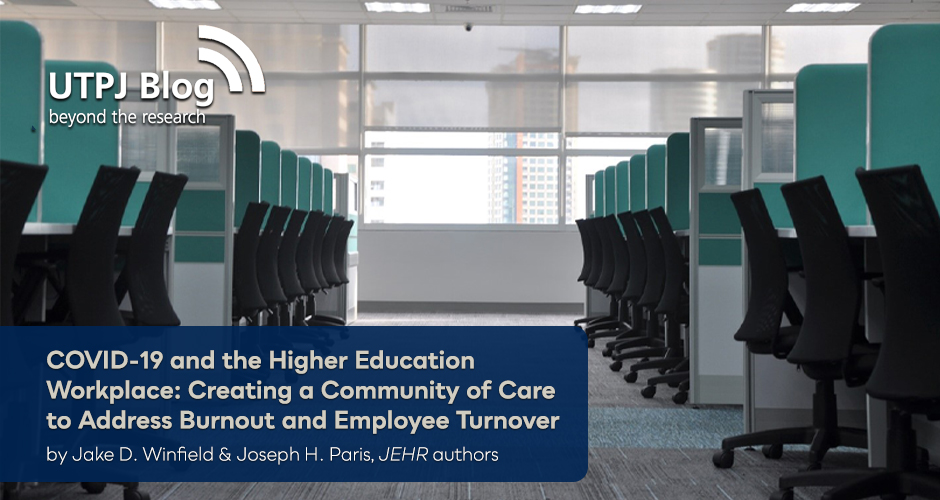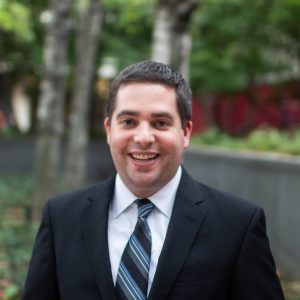
Photo by kate.sade on Unsplash.
Written by guest bloggers Jake D. Winfield & Joseph H. Paris
The COVID-19 pandemic has upended workplaces of all kinds, as work shifted online for many workers to provide safety. Our study of higher education working conditions in the United States during October 2020 highlighted the numerous ways that these changing work environments were associated with burnout and increased turnover intentions.
As we began our analysis of data collected using a mixed-methods survey, we expected respondents to describe an increased workload and burnout not only stemming from their work, but also from the stress of the COVID-19 pandemic. However, respondents also described additional challenges and personal impacts of the work environment on their lives. For example, individuals described how they were prescribed medication for anxiety or high blood pressure. Co-workers also became systems of support, as some respondents described having ‘breakdowns’ together and crying. Most troubling were instances when college and university administrators recognized the increased workloads but took minimal, if any, steps to alleviate concerns about burnout.
Our data capture a snapshot of experiences near the beginning of the pandemic, but concerns about working conditions have since expanded contributing to what has come to be known as the Great Resignation. Higher education has long struggled with employee retention. Our research and more recent data suggest that COVID-19 has exacerbated this longstanding issue. For example, the University of North Carolina System observed a 69% increase in staff turnover from July 2021 to January 2022 compared to the average staff turnover rate during these months over the previous four years. In our study, increased workloads during the pandemic were meaningful indicators of burnout and nearly all 957 student affairs professionals who responded to a survey in summer 2021 indicated that they expect their responsibilities to increase in the next five years. These increased workloads may result in higher levels of burnout and turnover in the near future. This is potentially troubling as jobs in higher education are now difficult to fill. For example, in November 2021, half of all Registrar’s office employees who responded to a survey had vacant positions – and 70% of those respondents found it difficult or very difficult to fill these open positions. Evidence continues to mount that a paradigm shift is necessary within higher education to ensure the sustainability of colleges and universities as healthy and productive workplaces.
One potential solution is for institutional leaders to cultivate a community of care for employees, directly challenging workplace norms in the field. Research in higher education has emphasized the important role that faculty and staff play in helping students feel that they belong on campus. It is unrealistic to expect higher education professionals to cultivate a welcoming campus environment while they are overworked and undervalued. Institutions can begin by collecting meaningful data from employees about their working conditions, listening deeply, communicating openly, and making meaningful changes. Such changes may include codifying remote work policies and increasing compensation. Transforming the higher education workplace may help address these issues to allow higher education professionals to do what they do best – support students.
About the Authors
 Jake D. Winfield is a PhD candidate in policy and organizational studies at Temple University’s College of Education and Human Development. Prior to graduate studies, he taught high school mathematics in Arkansas and Arizona. His research interests center on the intersection of community-university relationships and college access for minoritized students.
Jake D. Winfield is a PhD candidate in policy and organizational studies at Temple University’s College of Education and Human Development. Prior to graduate studies, he taught high school mathematics in Arkansas and Arizona. His research interests center on the intersection of community-university relationships and college access for minoritized students. Joseph H. Paris is an assistant professor of higher education at Temple University. His research and teaching focus on the intersection of institutional effectiveness and college student success and draw upon his professional experience in enrollment management and higher education marketing.
Joseph H. Paris is an assistant professor of higher education at Temple University. His research and teaching focus on the intersection of institutional effectiveness and college student success and draw upon his professional experience in enrollment management and higher education marketing.
Comments on this entry are closed.